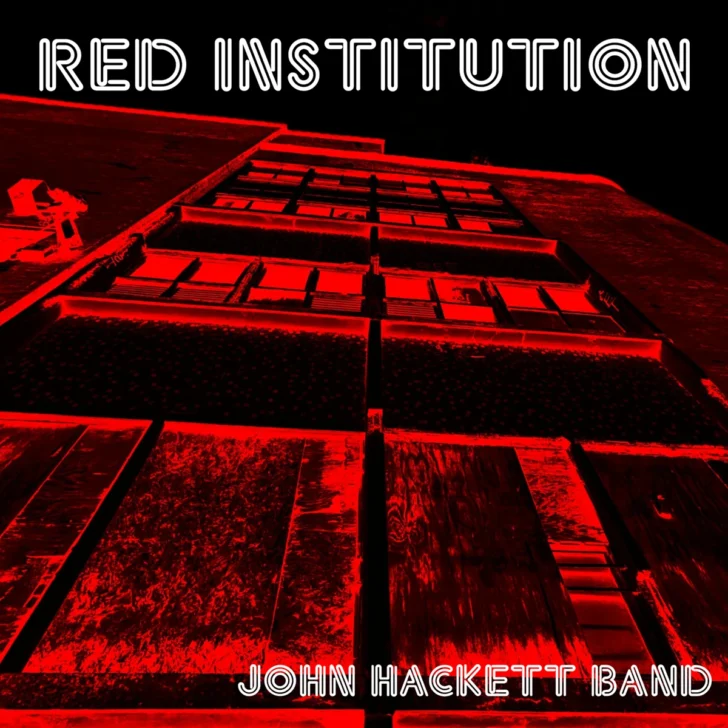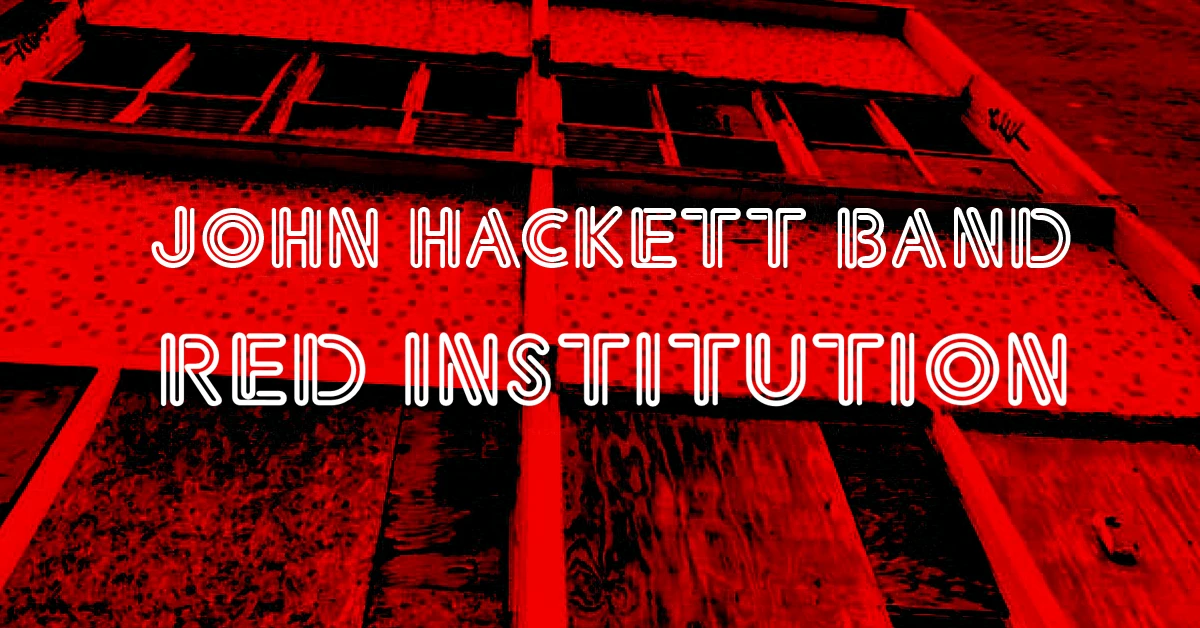- Article
- Read in 6 minutes
John Hackett Band – Red Institution – review
The new John Hackett Band album Red Institution will be released in April 2025. Thomas Jesse shares his thoughts
Background
The John Hackett Band was formed 10 years ago to promote John’s solo album Another Life 1. Since then they have played many live gigs and produced many (solo) albums. To celebrate this anniversary, the musicians have come together to record a new studio album. The band consists of John Hackett (flute, keyboards, vocals, 12 string), Nick Fletcher (guitars) 2, Duncan Parsons (drums) and Jeremy Richardson, (bass, lead vocals, keyboards, 12 string, guitars). All accomplished musicians 3, Nick Fletcher in particular has made a name for himself with some fine albums.
The promotional text speaks of musicians who have grown together as a unit in the 10 years they have been playing together, but who cannot deny their individual musical backgrounds of rock, jazz, prog, classical, pop and folk. Listeners can expect an album of impressionistic sounds full of joy, intelligence and power, sometimes calm and deliberate, sometimes loud and rocking. Now let’s get into the music and see if these words can be understood.
Songs
Stella (5:22)
The opener, written by Jeremy Richardson and Duncan Parsons, begins with soft drums, a keyboard reminiscent of Supertramp plays, the bass adds dabs and the vocals begin. Jeremy Richardson intones the title, guitar arpeggios add to the mellow mood. His singing sometimes even comes close to Brian Ferry. Not surprisingly, the slightly rocky pop song is reminiscent of Roxy Music or 10CC. The beautiful piano solo at minute 4:40 is remarkable – a fine prelude that arouses curiosity.

Theme & Rondo (4:27)
A flute solo by the composer of the piece, John Hackett, in baroque garb, which is picked up by Nick Fletcher’s guitar, forms the prelude to the fine instrumental. The jazz fusion folk style music-making is a real joy. At times it becomes complex like Gentle Giant, then floating with a dreamy solo guitar. Finally, guitar and flute dance around each other in the superb finale.
Who Let The Rain In? (5:39)
A flute makes the raindrops sound, keyboards and 12 strings turn them into a rain shower. A beautiful interplay between verses and chorus begins and causes an earworm. Before it gets too melancholy, a break changes the mood. It is driven to a crashing guitar solo. Finally, the noise collapses and the rain turns back into individual drops to fade out in a dark and gloomy synthesiser carpet. The Richardson, Parsons duo have composed a fine piece. Worth listening to and a possible single release.
Clare’s Tango (3:41)
The massive synthesiser sound leads us into the next song. It is picked up by a guitar trapped in the background of the room. A keyboard solo sets the stage for drums, bass and a jazzy guitar. The piece becomes increasingly dramatic and invites us to tango into the realms of UK and Bruford progressive rock. A marvellous, intelligent instrumental by Duncan Parsons.
MDLXXXIX (7:52)
M+D+LXXX+IX = 1000+500+80+9 = 1589 … that’s the title. And it is indeed the year in which the theme is set. According to Jeremy Richardson, the piece is about the events of the English Armada in the year of the title. The music is easier to place. Here we have progressive jazz rock with borrowings from the UK, Marillion, Weather Report, the Mahavishnu Orchestra and in the finale Steve Hackett drops in. The music is wonderfully relaxed, soundscapes alternate with frantic noise, a raging drum kit dances with a bubbling bass. The flutes are up to mischief. The plaintive vocals are framed by all this. Yes, there really is a harmonious band playing. This piece must be a live hit. What kind of song is this?
I Talk To The Wind (6:02)
The beautiful King Crimson piece was not only performed live by the John Hackett Band. No, his brother has also done it.4 What else is there to say about this classic? A showpiece for John’s flute skills. He makes it float gently. The instruments subordinate themselves to him, playing a restrained round dance, also to allow Jeremy Richardson to sing a duet with the divine Amy Birks 5. Fripp would have loved that.
Too Easy (5:43)
A cool rock-pop uptempo number with small melodic changes follows. John Hackett takes over the lead vocals. Not only him, but the whole song reminds you of Al Stewart. Before it gets too quiet, the dominant guitar takes on a faster style. The music is a bit metal-heavy. John Hackett doesn’t want to be asked for long and treats us to another minute of his skillful singing.
The Commitee (6:58)
Bar singing next to floppy guitar, krautrock-like plinking piano cascades, is that possible? When all of this is stirred into a concoction of soul and funk and mutates into a short-breathed jazz-rock cracker in the second half, we have heard one of the most varied and intelligent pieces on the album. Not only do the instrumentalists shine, but the vocalists congenially recite the wandering melodies, tones and sounds. The highlight of the album comes from the pen of Duncan Parsons.
Brotherhood (2:53)
This quiet little tune was composed by John Hackett. The title indicates that the musically fruitful brotherhood between John and Steve is the theme here. The flute and guitar dance around each other in slow time. It is reminiscent of Defector when the flute dances like a butterfly above the languorous guitar. Beautiful!
Butterfly Banshee (5:55)
The guitar and piano quietly carry us into the room. Only after a minute does it open up and the music leads to the vocals. The playful tone with its harmonies, which occasionally break out louder, is reminiscent of Canterbury music. Camel and above all Caravan are the inspiration here. A piece of brittle beauty. The banshee cannot be captured so quickly, not even by a beguiling final flute. Jeremy Richardson and Duncan Parsons brought her to life.
A Country Gentleman (4:40)
… picks up on the mood of its predecessor. However, it becomes much more pastoral. You would think Ant Phillips had teamed up with Vaughan Williams. John Hackett’s composition even plays with strings before the band enters at the 1:20 minute mark. Wonderfully sustained, floating, like a summer’s day with a gentle breeze. The duet of flute and piano emphasises the impressionistic picture.
Red Institution (5:05)
Things finally pick up. The finale is a loose rock number in which the bass and drums are very pleasing. Getting faster and faster, it only calms down again with a flute at the end. Yes, a bit of “lite-prog” a la Alan Parsons closes the album.
All in all
The John Hackett Band has created a harmonious album full of exciting contrasts. Music between prog-rock and quiet, classical-tinged songs, between pop and even folk. As the Canterbury scene was, so is the album: quintessentially British. A pastoral country mood prevails, with jazz-rock excursions contrasting with it and singing the praises of the city’s culture. The band plays wonderfully together. Despite all the harmony, the individual musical influences of the musicians can be heard. Jeremy Richardson’s vocals are rather unobtrusive, not prone to loud outbursts.
But he miraculously holds the songs together. John Hackett impresses above all with his breathtaking flute playing. Alongside the flute, Nick Fletcher’s guitar is the undisputed lead instrument. The way he dances between styles and musical idols is breathtaking. However, he always remains himself and is one of Britain’s greatest contemporary guitarists. However, Jeremy Richardson’s bass and Duncan Parsons’ drumming should not go unmentioned, as they hold the band together so that the soloists always find their way back.
The result is a successful, timeless album, far removed from all current popular music, which shows the light side of jazz rock and progressive rock and serves other musical styles (funk, soul) without becoming too shallow. The music forms a contrast to the dark, gloomy cover. A house wall at night is illuminated in dark red. An intelligent album that demands to be listened to, but can equally be enjoyed via the medium of dance. Good (rock) music doesn’t always have to be pregnant with meaning or boast glorious solos. The album sticks to this and will hopefully find many fans.
John Hackett Band on tour
The band will be touring with the album, mainly in the UK. If you have the chance to see them, you should take it. All tour dates can be found on our tour dates page here.
Author: Thomas Jesse
References:
1 See: John Hackett – Another Life (2015) – news piece
2 See our reviews about Nick’s fantastic albms
3 see here
4 See: Steve Hackett – The Tokyo Tapes: Live In Japan (1997)
5 See: Living & Alive (Beatrix Players, 2023)
6 See: Live Shows – Hacktrax
The album will be released on 11 April 2025 and can be ordered via the John Hackett Webstore.


